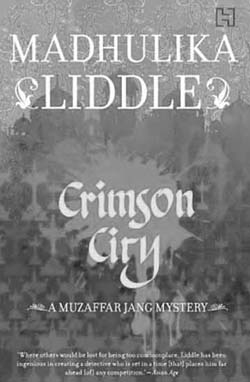Crimson City, the fourth Muzaffar Jang mystery by Madhulika Liddle, is a whodunit set in mid-seventeenth century Dilli with the Mughal court as its backdrop. Emperor Shah Jahan’s grandiose plans have begun to deplete the exchequer dangerously. A Mughal army is besieging the fort of Bidar, as a first step towards conquering the Bijapur kingdom with its enormous wealth.
When a prosperous cloth merchant is murdered, the murdered man’s neighbour, Muzaffar Jang, the intuitive detective, is warned by his brother-in-law the Kotwal of Dilli not to interfere with the workings of the law and its henchmen. Disregarding this advice initially earns him a sharp reprimand from the Kotwal. Rather reluctantly he decides to acquiesce, much to the distress of his newly married wife, Shireen.
However, his pious resolution is shaken when a series of seemingly unrelated murders occur around him. His neighbourhood is tossed into turmoil. The Thanedar and the other law keepers are totally helpless to deal with the mayhem around them. Then, through a series of disclosures and guesses, Muzaffar Jang realizes that the reputation, if not the very life of his brother-in-law is threatened if the murders are not solved. Willy-nilly he is drawn into the case which he ultimately solves with the help of Shireen.
This is the story in the main. And, it takes a number of twists and turns before it races to the end. Where the author scores (and this is without any derogatory comment about the story) is in her descriptions of the society—a veritable social history of 17th century Dilli with its underbelly of corruption and sleaze, covered, rather inadequately by the pomp and grandeur of the Mughal court of which Muzaffar Jang is a minor noble. Both private and public places are described in exquisite detail. The story-tellers of Chandni Chowk operating next to the coffee shops, the cobblers as purveyors of gossip, the intimacy, yet distance of shopkeepers from their customers, an exotic cocktail where a leisurely horse ride to a hamaam (bath house) becomes a metaphor of both the good and the bad in Shahjahan’s empire. The houses, their enclosed courtyards, the luxurious rooms, the rich furniture bring the times to life. Without straining Liddle has painted a tapestry of contemporary society with its veneer of sophistication that covers the rot and stench underneath.

